Bot Settings
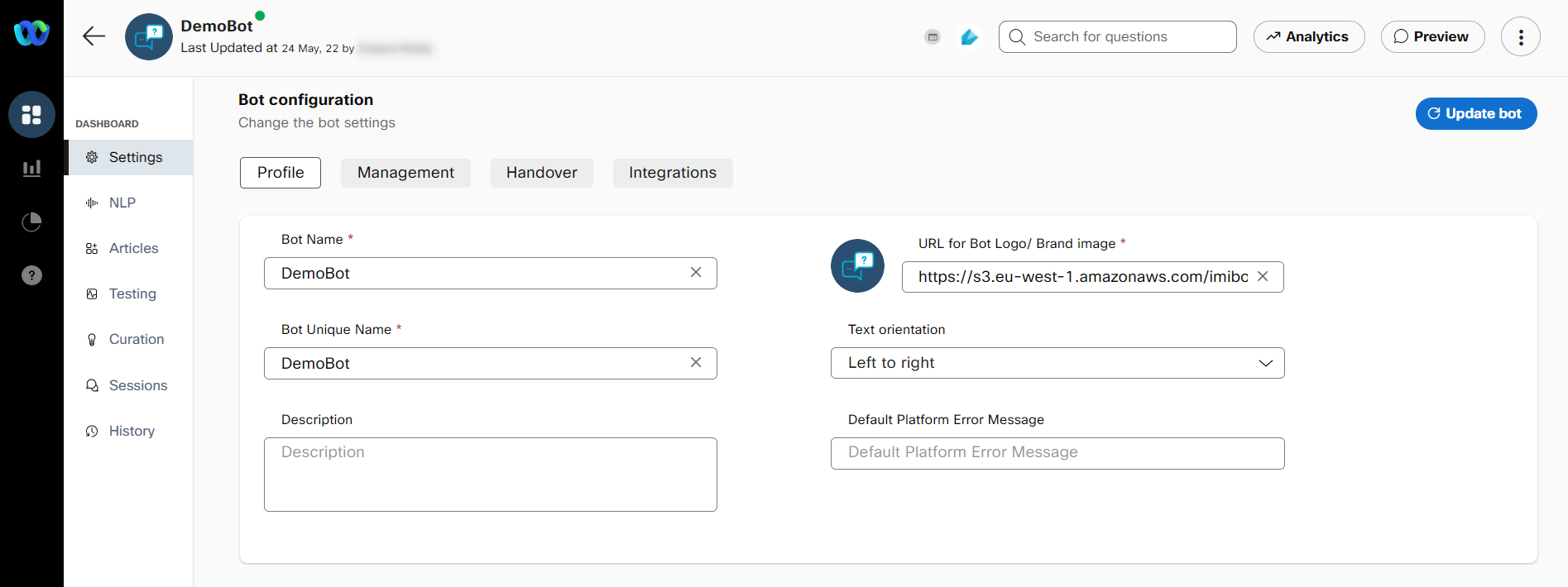
The Settings section has all the bot level settings. All these configuration information has been further categorized into 5 sections:
- Profile
- Management
- Handover
- Integrations
Profile
This tab contains settings related to the bot’s profile, which captures all vital details about the bot.
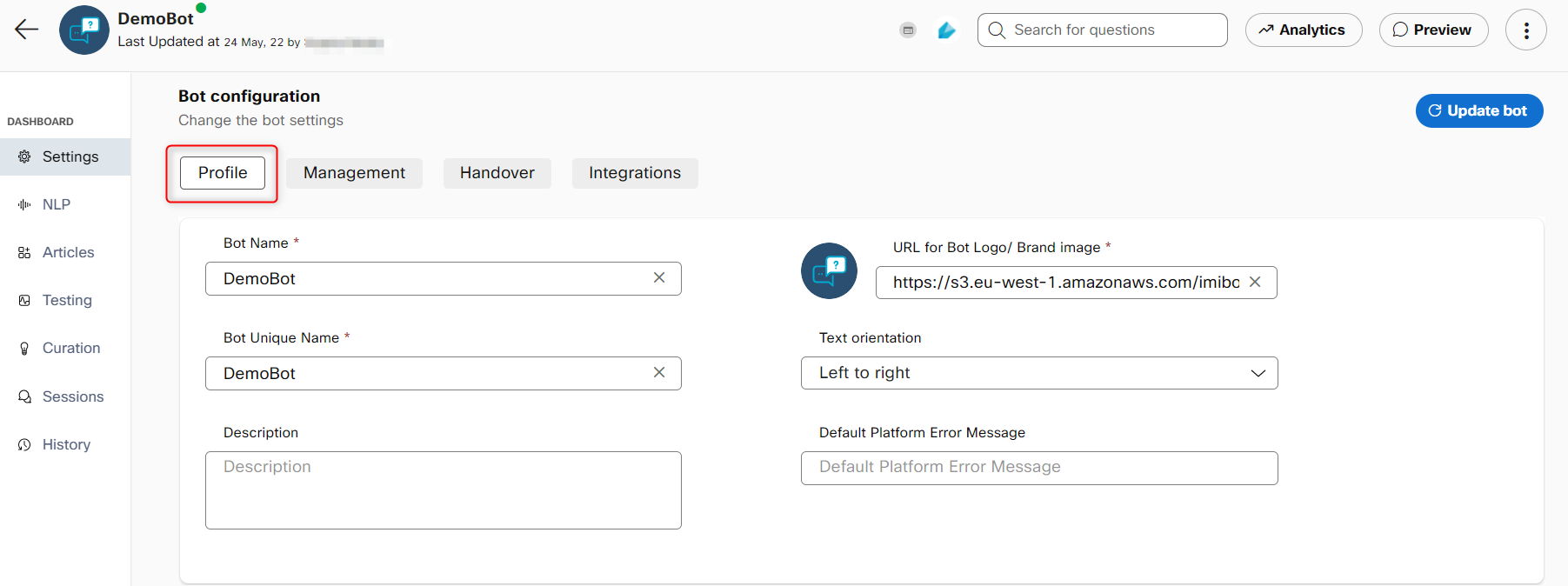
Profile settings of a bot
The following table describes about each field on the Profile tab:
| Field | Description |
|---|---|
| Bot Name | Display name for the bot. When the bot is accessed, the name of the bot will be displayed in the bot chat window beside the bot logo. Also, this is the name by which the bot is identified in other sections on the platform such as in Analytics, Reports, etc. |
| Bot Unique Name | A unique name for the bot that appears in the Bot URL that is used to chat with the Bot. This name is auto-generated from the Bot Display Name but can be edited by the developer. The Bot Unique Name needs to be unique across an enterprise. |
| Bot Description | Additional information about the bot functioning. |
| URL for the bot/Brand Image | The URL for the bot logo. The logo is displayed at the top left corner beside the bot name in the bot chat window. |
| Default Platform Error Message | This is the message that bot will respond with whenever it encounters an input that is not covered by its scope or 'common sense' intents |
| Text orientation | Display of text format on the platform. Possible values: Left to right (English) Right to left (Arabic) |
| Time zone | Time of a particular country/city. This field is displayed only on the Profile tab of task bots. |
Management
This tab captures information about bot sessions' functioning and closing.
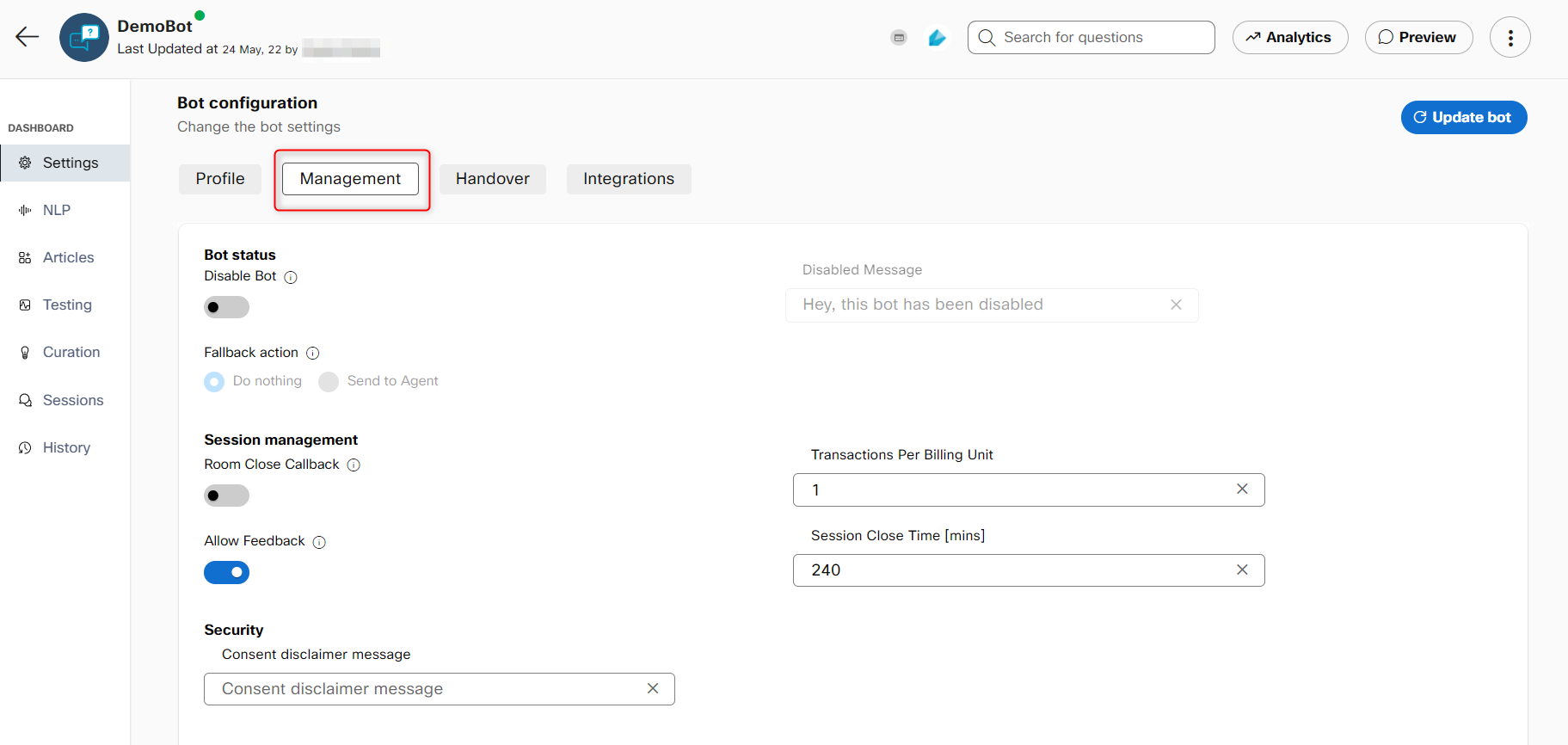
Management settings
The following table describes about each field in this tab.
| Field | Description |
|---|---|
| Disable bot | Turn on this toggle to make the bot unavailable. |
| Disabled message | The message that must be displayed to consumers who try to access the disabled bot. Note: This field is enabled only when the Disable bot toggle is turned on. |
| Fallback action | Select this option to take an appropriate action on the incoming messages to the bot. Possible values: Do nothing: No action is taken. Send to Agent: The chat is handed over to an agent based on the incoming messages to the bot. |
| Room Close Callback (Session management section) | Trigger callback API before a room is about to close. |
| Allow Feedback | Turn on this toggle to request feedback from users about usefulness of every bot reply. The consumer is given options to determine whether the bot response was useful or not after every bot message in a session. |
| Session close time (mins) | The session time-out (in minutes), after which the session will be closed automatically in the scenario of user inactivity. The default value is set at 240 minutes |
| Transactions Per Billing Unit | The number of transactions that can be performed for every billing unit. |
| Consent disclaimer message (Security section) | The disclaimer message for the consent. This field is available only if you enable the Advanced data protection option. This option has moved to the backend. When this is set to True, you can view this field. |
Handover
This section contains settings related to the bot’s handover, which decides when a user will be handed over to a human agent.
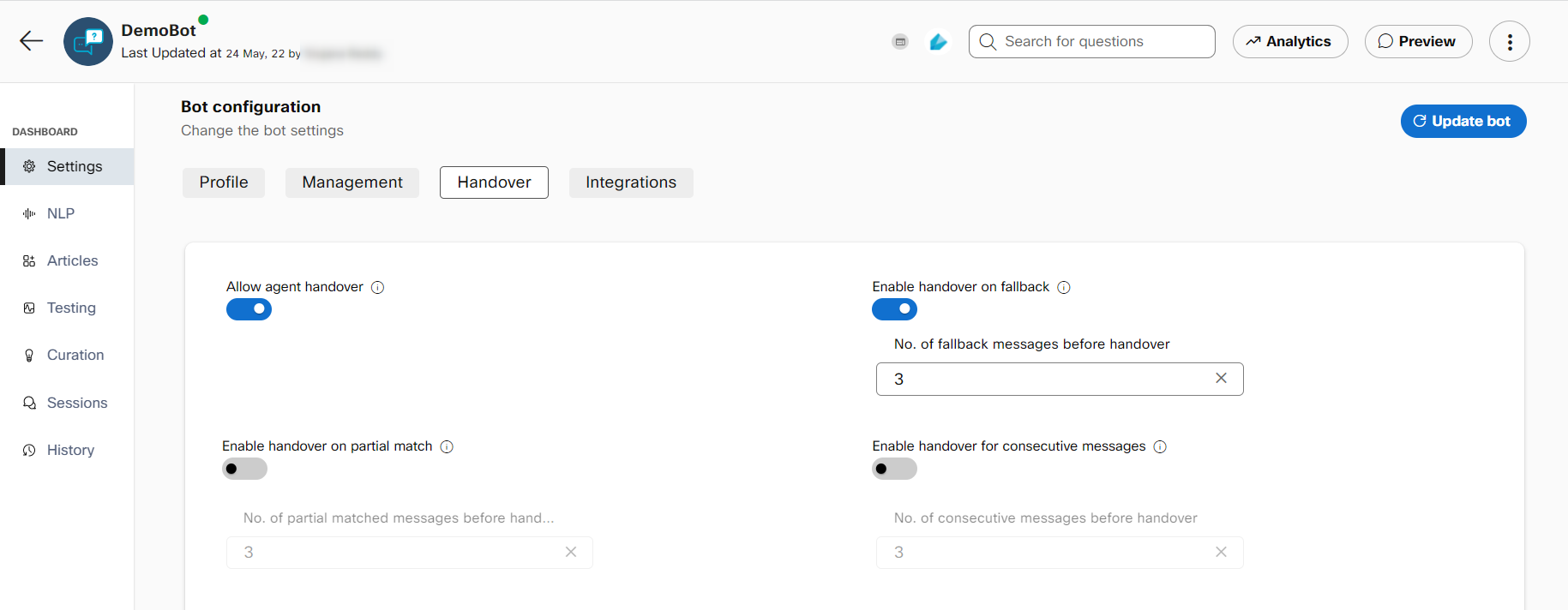
| Field | Description |
|---|---|
| Allow agent handover | Transfer the user to an agent when the bot isn’t able to handle their queries or if they explicitly ask for it. When the agent handover toggle is disabled, developers can use the response of this article to specify that no human handover provision is available. In such cases, subsequent consumer messages will be addressed by the bot even after invoking ‘Talk to an agent’ article. Enabling the agent handover setting will hand over consumers to the configured customer care platform on invoking this article. If the bot corpus is exported as a CSV, the file will not contain this article. |
| Enable handover on fallback | A number of consecutive fallback messages in a session can trigger an agent handover. This number is configurable in the provided text box. |
| Enable handover on partial match | A number of consecutive partial matches in a session can trigger handover. This number is configurable. |
| Enable handover for consecutive messages | Consecutive repeated messages in a session can trigger agent handover. The number of repetitions needed for this trigger is configurable. |
Integrations
The Integrations tab provides the bot developer with the ability to quickly deploy
the same bot across several channels such as Skype, Line, Viber, Facebook Messenger,
Slack, Alexa, Google home and several others.
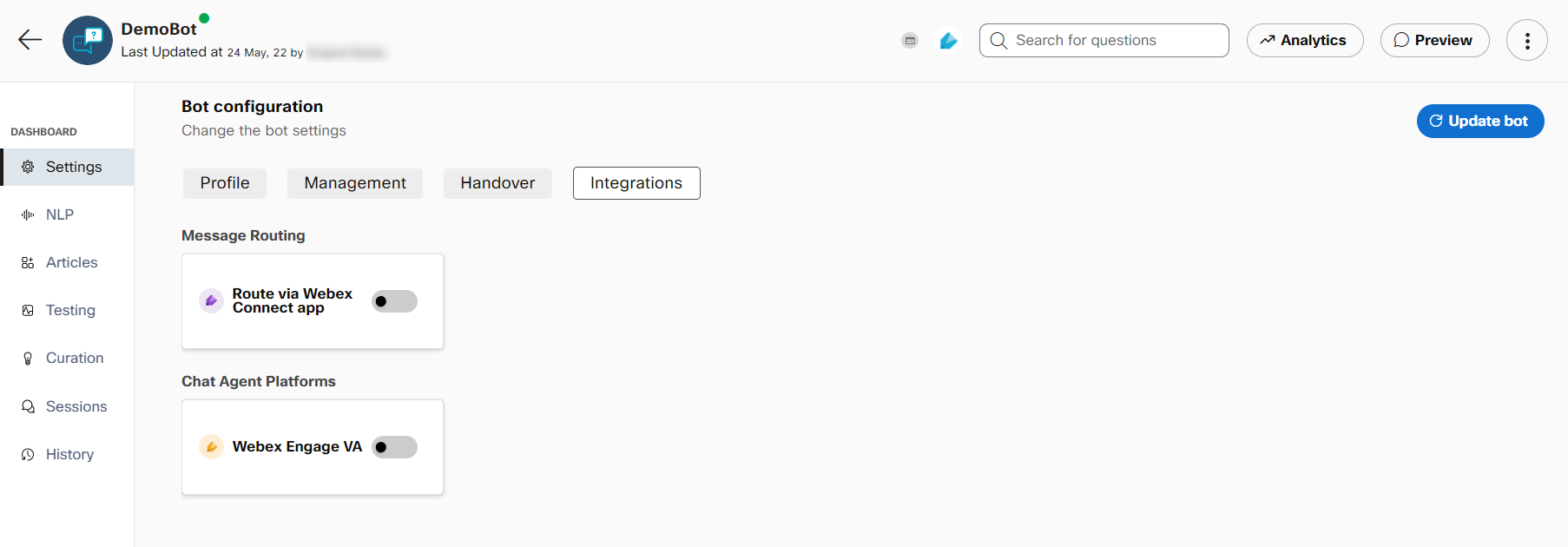
Route via Webex Connect app
Real-world solutions will require DB lookups, fulfilment, and communication with external systems, which is achieved through connect flows. Route via Webex Connect app toggle is used as a message routing option in both Q&A and Task bots to test connect flows end-to-end for the web channel.
When this is toggled off, the bot preview will query the bot. If this toggle is enabled, you can configure the app created in Webex connect on the Webex Bot builder by providing the app ID, app secret (client key), and service key in which bot flows are created. Once these details are provided and the bot is updated, any message sent to bot preview will be redirected to connect app and service that is configured. The response in the bot preview will depend on the connect flow that is configured . This allows you to test and share (via preview link available in the Bot builder) the overall connect flow.
Routing via Webex Connect app
Use this procedure to route consumer messages via Webex Connect app.
- Select a specific Q&A or task bots whose consumer messages must be routed via imiconnect app from the dashboard screen of the Bot builder. The Bot Configuration screen appears.
- Click the Integrations tab. The following screen appears.

- Enable the Route via Webex Connect app toggle. Enabling this toggle displays the following fields.
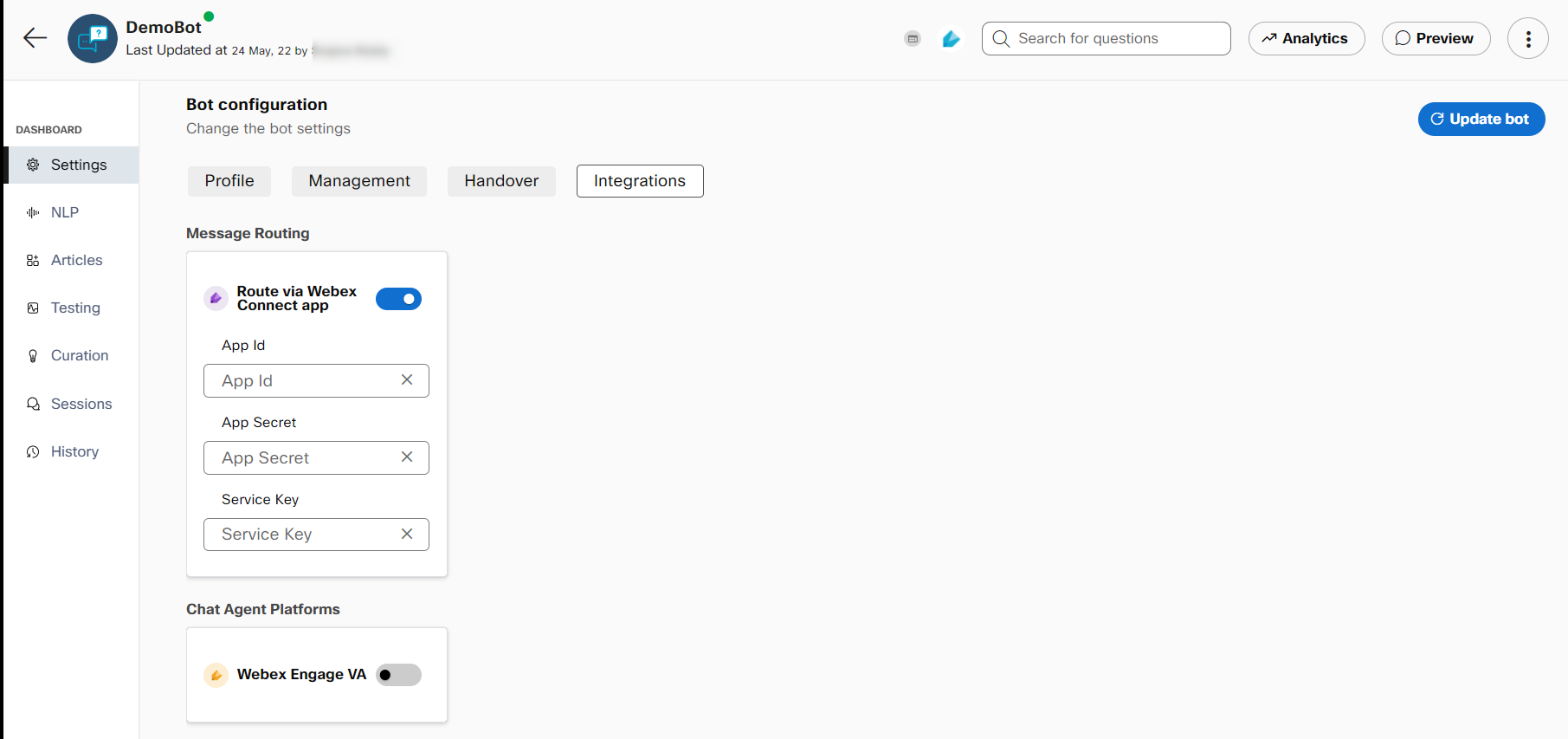
Fields displayed by enabling the Route via imiconnect app toggle
- Specify this information:
App Id
The App Id of the digital channel. This Id is obtained from the imiconnect application.
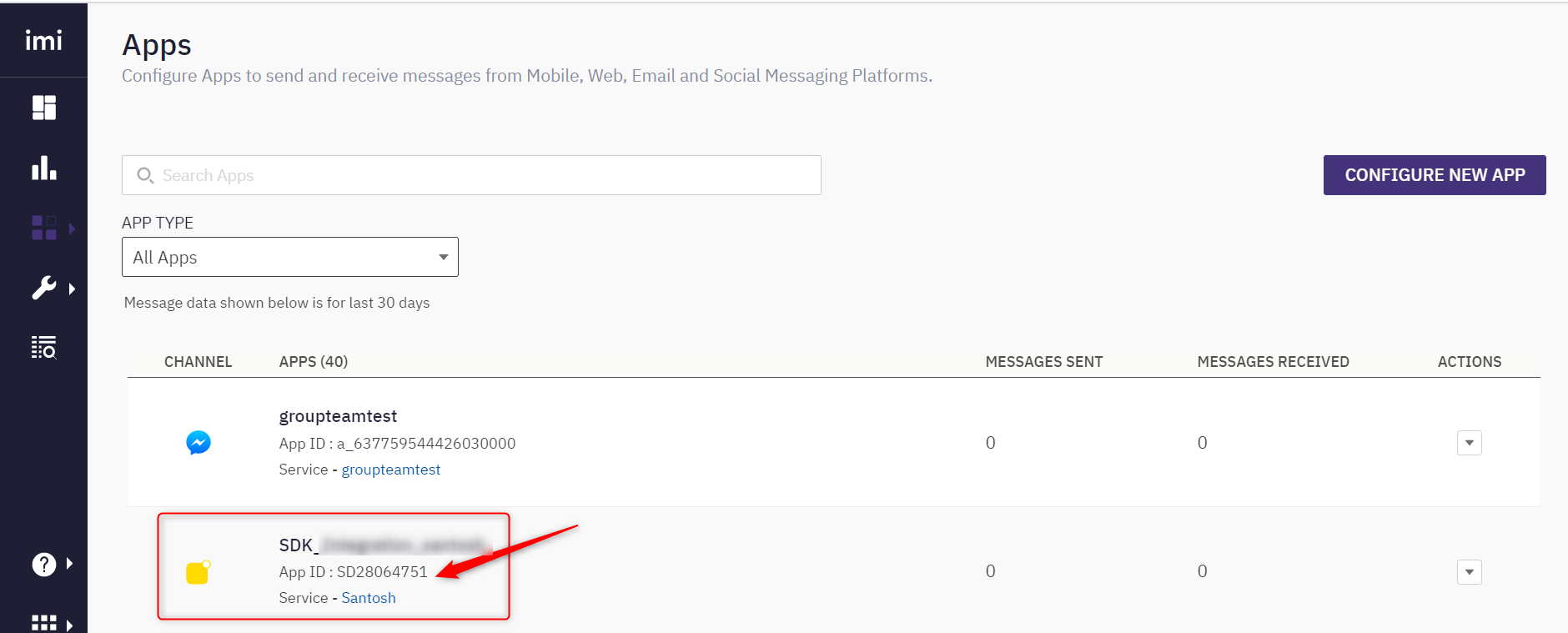
App Secret
The client key that is obtained from the imiconnect application.
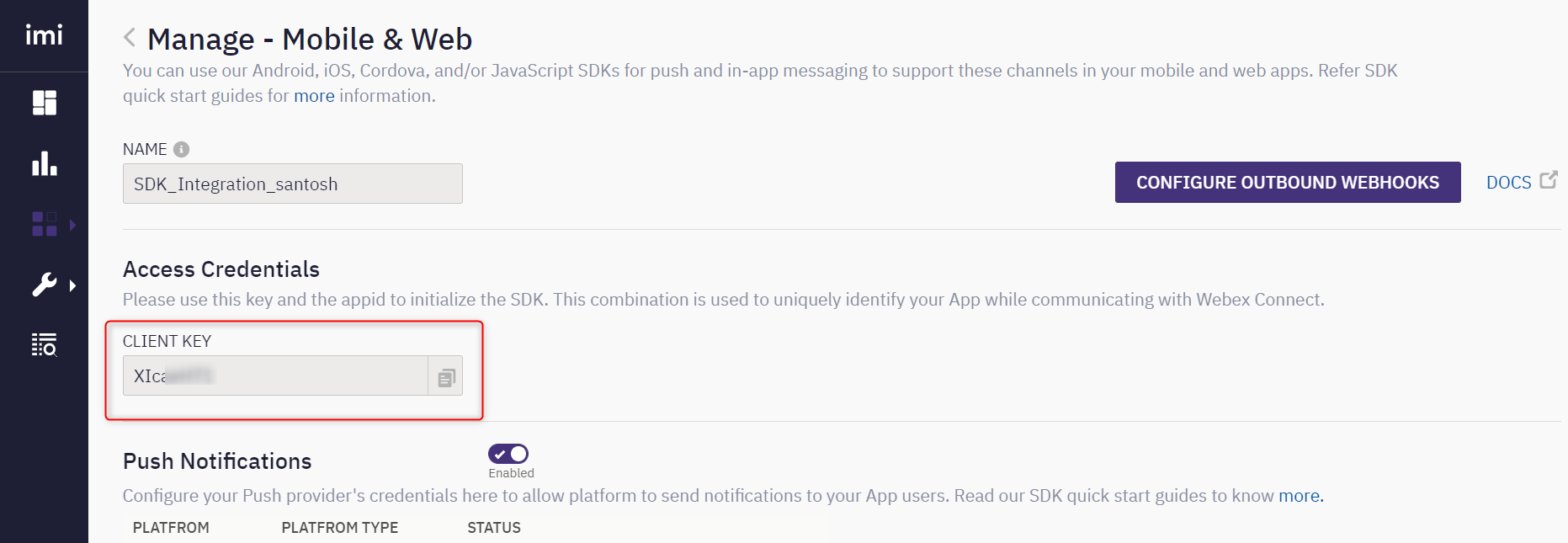
Service key
The service key in which the bot flows are created in imiconnect.
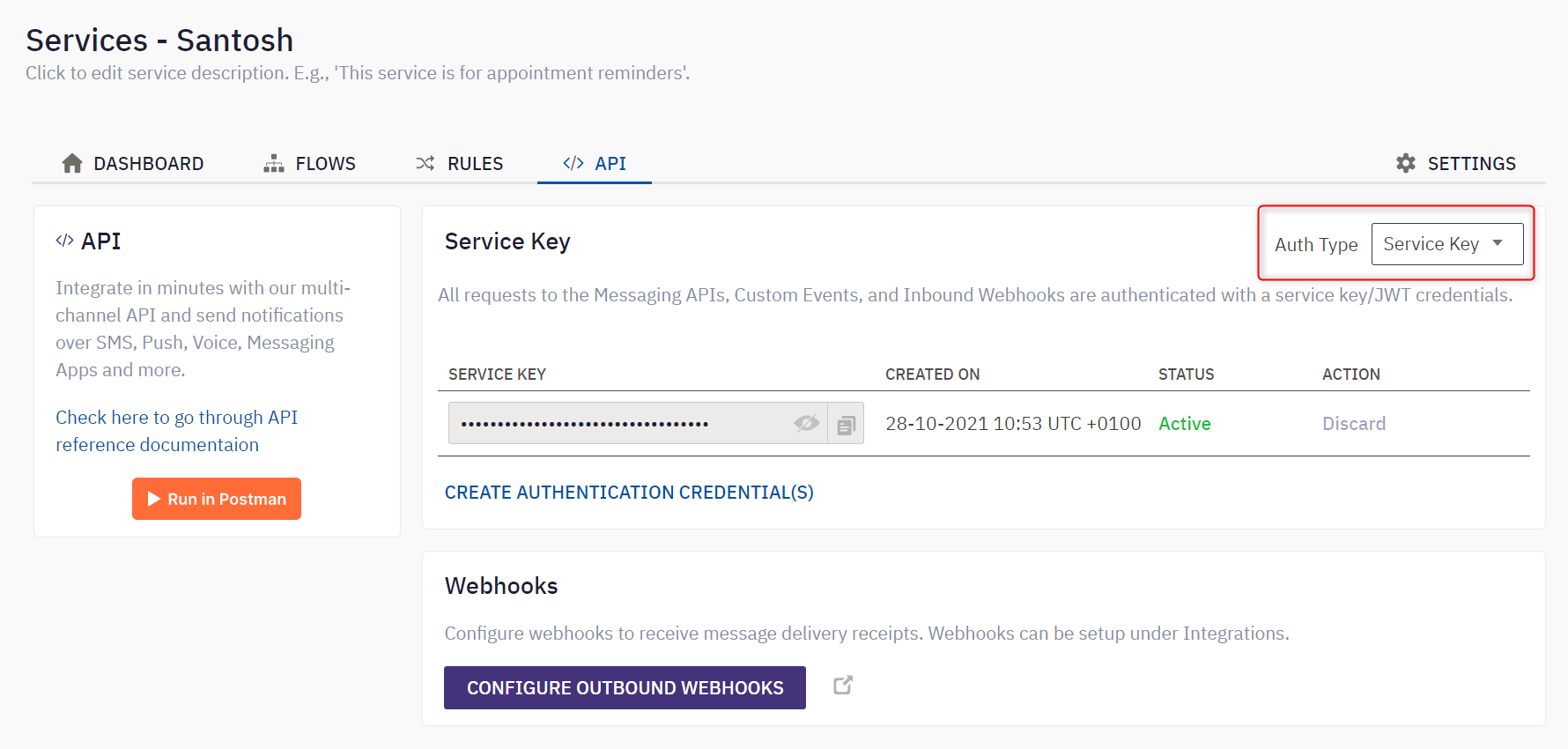
- Click Update Bot. The following window is displayed prompting the disablement of Allow feedback toggle on the Management tab of the Bot configuration screen. This toggle is disabled automatically, enabling the route via imiconnect app toggle. As long as the Route messages via imiconnect app toggle is enabled, you cannot use the Allow feedback toggle.
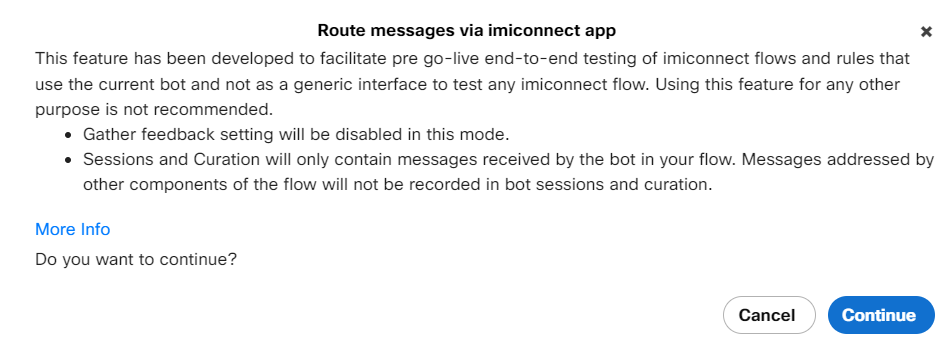
- Click Continue.
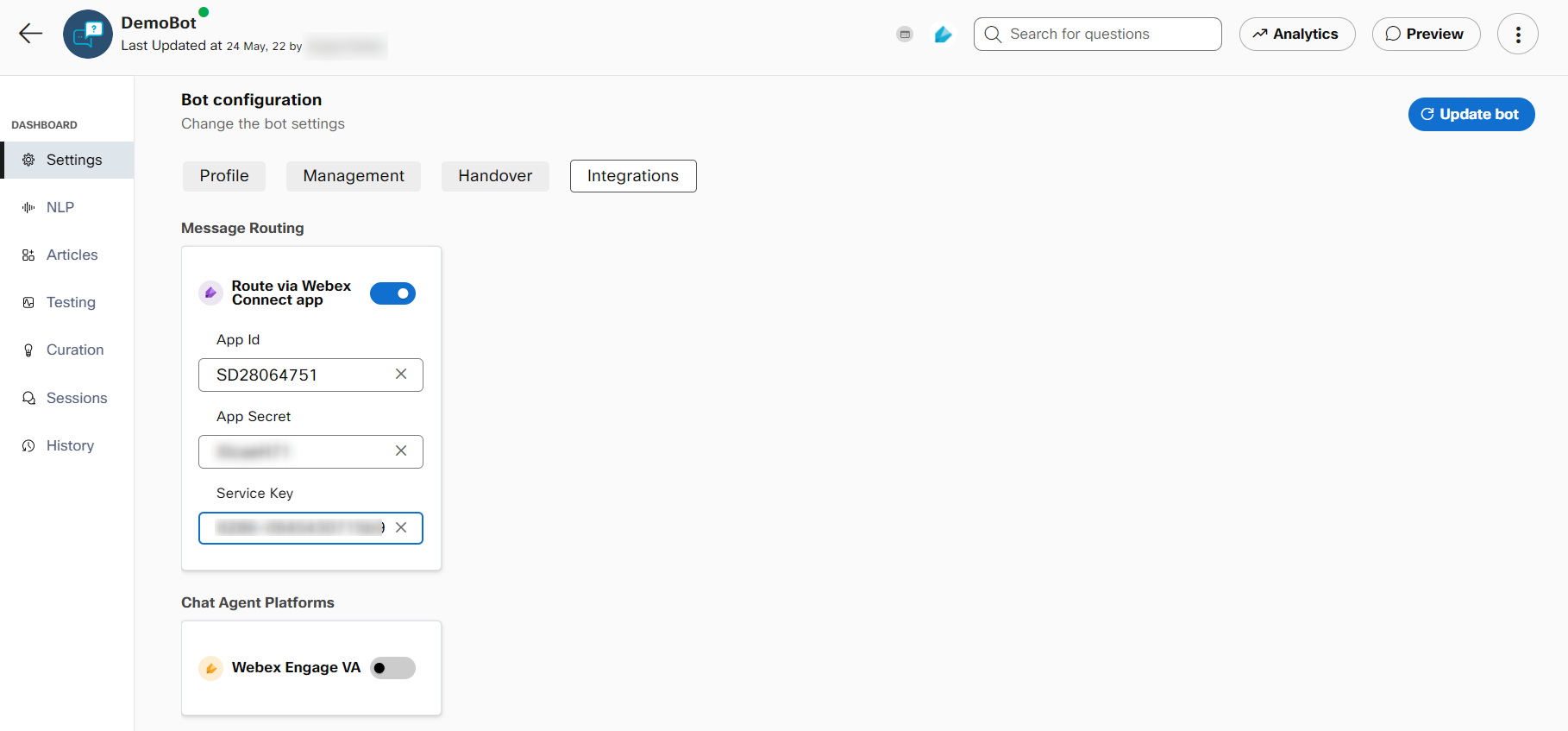
Once the bot settings are updated, you can view the icon indicating the enablement of Route via imiconnect app toggle on the bot dashboard screen as follows
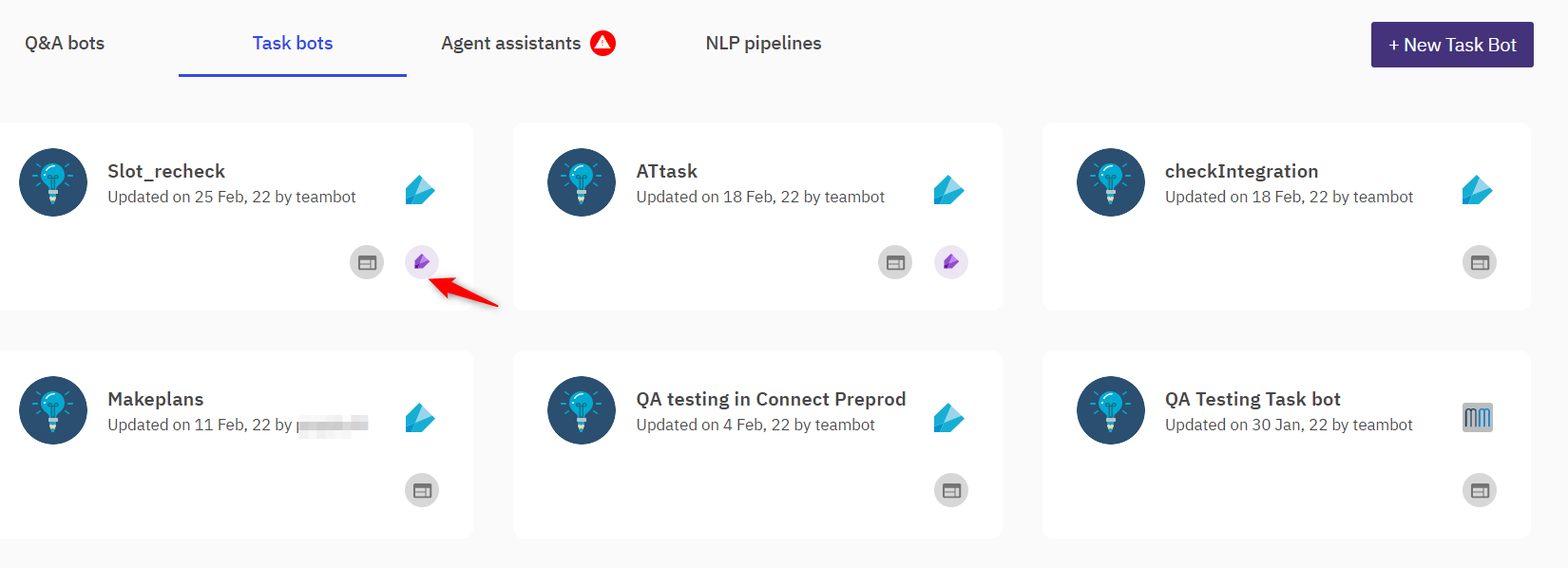
Icon indicating the Route via imiconnect app toggle enablement on the bot dashboard screen
An announcement is logged on the preview widget of the bot if the imiconnect flow or rule is configured in the bot's setting.
For more information, see routing via imiconnect app
For more information, see Using bot as a virtual agent in Webex engage
Updated 5 months ago
